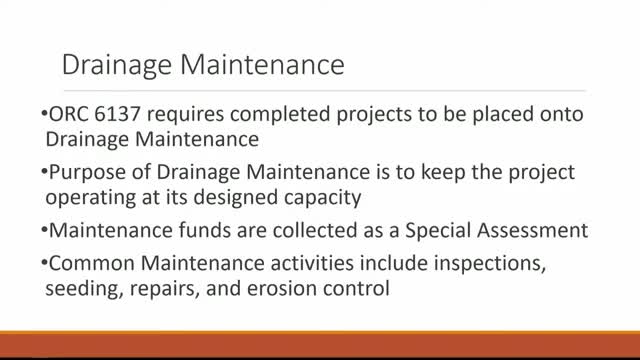Drainage improvements promise millions in agricultural benefits
September 13, 2024 | Delaware County, Ohio
This article was created by AI summarizing key points discussed. AI makes mistakes, so for full details and context, please refer to the video of the full meeting. Please report any errors so we can fix them. Report an error »

During a recent government meeting, officials discussed the implementation and financial implications of drainage maintenance projects under ORC 6137. The regulation mandates that completed projects be placed under ongoing maintenance to ensure they operate at their designed capacity. Maintenance funds are collected through special assessments, similar to construction assessments, with common activities including inspections, seeding, repairs, and erosion control.
The meeting highlighted that maintenance assessments typically range from 2.5% to 5% annually, depending on the specific needs of each project. For example, a construction assessment of $7,800 would incur an annual maintenance fee of approximately $238.68, which is collected alongside the construction assessment until it is fully paid off.
The economic benefits of improved drainage were also a focal point, particularly for agricultural parcels. Enhanced drainage can significantly increase crop yields, with estimates suggesting an average increase of 46 bushels per acre for corn and 14 bushels per acre for soybeans. Given the USDA average crop prices from 2018 to 2022, the total estimated annual benefit for agricultural land in the watershed could reach over $215,000, translating to a potential 20-year benefit of approximately $4.3 million.
Specific examples were provided for different sections of the watershed, illustrating the financial advantages of improved drainage. For instance, in the McElwee area, the average annual benefit for corn and soybeans combined could amount to nearly $68,700, while the Krabble area could see an average benefit of about $14,900.
In addition to agricultural benefits, the meeting addressed the positive impacts on residential properties, which include improved quality of life and enhanced neighborhood perception. The cost of repairing failed sewage treatment systems can range from $15,000 to $25,000, while new developments typically invest around $8,700 per lot for adequate drainage solutions. With 42 residential parcels in the watershed, the overall benefit from improved drainage for these properties is estimated at approximately $365,400.
Overall, the discussions underscored the critical role of effective drainage maintenance in enhancing agricultural productivity and residential quality, reinforcing the importance of ongoing investment in these infrastructure projects.
The meeting highlighted that maintenance assessments typically range from 2.5% to 5% annually, depending on the specific needs of each project. For example, a construction assessment of $7,800 would incur an annual maintenance fee of approximately $238.68, which is collected alongside the construction assessment until it is fully paid off.
The economic benefits of improved drainage were also a focal point, particularly for agricultural parcels. Enhanced drainage can significantly increase crop yields, with estimates suggesting an average increase of 46 bushels per acre for corn and 14 bushels per acre for soybeans. Given the USDA average crop prices from 2018 to 2022, the total estimated annual benefit for agricultural land in the watershed could reach over $215,000, translating to a potential 20-year benefit of approximately $4.3 million.
Specific examples were provided for different sections of the watershed, illustrating the financial advantages of improved drainage. For instance, in the McElwee area, the average annual benefit for corn and soybeans combined could amount to nearly $68,700, while the Krabble area could see an average benefit of about $14,900.
In addition to agricultural benefits, the meeting addressed the positive impacts on residential properties, which include improved quality of life and enhanced neighborhood perception. The cost of repairing failed sewage treatment systems can range from $15,000 to $25,000, while new developments typically invest around $8,700 per lot for adequate drainage solutions. With 42 residential parcels in the watershed, the overall benefit from improved drainage for these properties is estimated at approximately $365,400.
Overall, the discussions underscored the critical role of effective drainage maintenance in enhancing agricultural productivity and residential quality, reinforcing the importance of ongoing investment in these infrastructure projects.
View full meeting
This article is based on a recent meeting—watch the full video and explore the complete transcript for deeper insights into the discussion.
View full meeting
